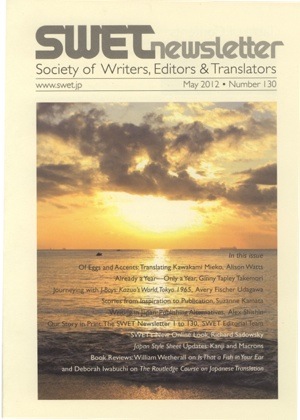May 20, 2012
SWET Newsletter, No. 130
- March 11, 2011: Continuing Stories
- Already a Year—Only a Year, by Ginny Tapley Takemori
- SWET Events
- Journeying with J-Boys: Kazuo’s World, Tokyo 1965, by Avery Fischer Udagawa
- Stories from Inspiration to Publication, by Suzanne Kamata
- Writing in Japan: Publishing Alternatives, by Alex Shishin
- From the Steerage
- Our Story in Print: The SWET Newsletter 1 to 130
- SWET’s New Online Look, by Richard Sadowsky
- Japan Style Sheet Updates
- Kanji in English Text
- Macrons and Other Diacritics
- Book Reviews
- Translating Translation: David Bellos, Is That a Fish in Your Ear, by William Wetherall
- Hasegawa’s Course in Translation, The Routledge Course in Japanese Translation, by Deborah Iwabuchi
More details . . .
Japanese to English Translation
- Of Eggs and Accents: Translating Kawakami Mieko, by Alison Watts
Alison Watts reviews lessons she learned about literary translation while tackling Chichi to ran (Breasts and Eggs) by Kawakami Mieko at the Summer School Workshop held by the British Centre for Literary Translation in July 2011. This article is based on a presentation given at a conference organized by the Japan Association of Translators in Nagoya, November 2011.
March 11, 2011: Continuing Stories
- Already a Year—Only a Year, by Ginny Tapley Takemori
Translator and book editor Ginny Tapley Takemori writes how the triple disaster that hit eastern Japan last year connected her in unexpected ways to her local community in Tsukuba, Ibaraki prefecture, and to a community in Ishinomaki, Miyagi prefecture, that was devastated by the tsunami. While volunteering in the reconstruction effort, she has been impressed by how survivors have found the strength to pick up the pieces of their shattered lives with warmth and humor. “It has been a defining experience in my own life,” she says.
SWET Events
- Journeying with J-Boys: Kazuo’s World, Tokyo 1965, by Avery Fischer Udagawa
Shogo Oketani, author of J-Boys: Kazuo’s World, Tokyo, 1965 (Stone Bridge Press, 2011), and his wife, Leza Lowitz, spoke to members of SWET and SCBWI Tokyo on December 6, 2011. Avery Fischer Udagawa, the translator of J-Boys, joined via Skype in the exchange, which was moderated by Holly Thompson at the Wesley Center in Minami Aoyama, Tokyo. The conversation traced the development of J-Boys from linked stories in Japanese for teens and up to a novel in English for middle grade (upper elementary) readers. Udagawa reflects further on the education the project afforded her in middle grade historical fiction.
- Stories from Inspiration to Publication, by Suzanne Kamata
Suzanne Kamata spoke to SWET Kansai on September 11, 2011, about writing, editing, and publishing short stories using her own experience. She discussed how she comes up with ideas for her short stories, and suggested how aspiring writers might come up with their own; how she selects markets for her work; and how she found (and lost and found again) a traditional publisher for her work. Her collection, The Beautiful One Has Come, won a Silver Nautilus Award and was a winner for best short story collection in the Next Generation Indie Book Awards.
- Writing in Japan: Publishing Alternatives, by Alex Shishin
Describing experiences with publishing fiction and nonfiction over three decades, Alex Shishin’s March 11, 2012 Kansai SWET talk recalled the opportunities available to writers in Japan during the print-dominated era and the new conveniences and opportunities now available via the Internet. Shishin is a professor at Kobe Women’s University, where he teaches literature and writing.
From the Steerage
- Our Story in Print: The SWET Newsletter 1 to 130
- To mark the publication of the 130th issue of the SWET Newsletter, and the transition to new means of information sharing in SWET, members of the Editorial Team contributed to this Q&A about the Newsletter’s past and present. We hope this exchange will both add to the record of an era in SWET’s history and help readers appreciate the professionalism and sense of mission of the many volunteers and contributors over the years since the first issue was published in 1981.
- SWET’s New Online Look, by Richard Sadowsky
This year SWET enters a new era with a redesigned and enhanced website at swet.jp setting the groundwork for SWET’s future development. From now on, the website will be the place to go for SWET news, articles, and information for members and others with an interest in SWET topics. The launch is currently planned for the end of June 2012.
Japan Style Sheet Updates
Editors, translators, and proofreaders turn to the Japan Style Sheet (Stone Bridge Press, 1998) in making style decisions for their work related to Japan. While the editorial options and recommendations given in JSS are as reliable as ever, technology has moved on, resolving some of the difficulties regarding inclusion of kanji and macrons (long-vowel marks for romanized Japanese). This article updates the JSS on “Using Kanji in English Text” and augments and corrects the advice on long vowels in “Macrons and Other Diacritics.” Copies of the Japan Style Sheet are available at discount from SWET by contacting info@swet.jp.
Book Reviews
- Translating Translation by William Wetherall
Is That a Fish in Your Ear? Translation and the Meaning of Everything, by David Bellos. (New York: Faber and Faber, 2011). viii + 373 pages.
- Hasegawa’s Course in Translation, by Deborah Iwabuchi
The Routledge Course in Japanese Translation, by Yoko Hasegawa. (London: Routledge, 2012). ISBN 978-0-415-48686-6. Price ¥4,092).

